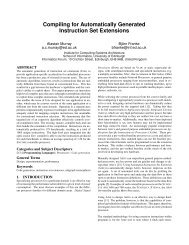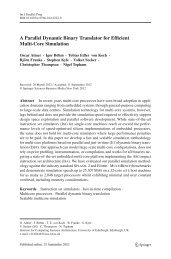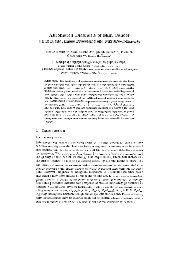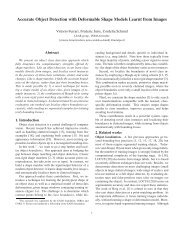WebExp2 Experimenter's Manual - School of Informatics - University ...
WebExp2 Experimenter's Manual - School of Informatics - University ...
WebExp2 Experimenter's Manual - School of Informatics - University ...
Create successful ePaper yourself
Turn your PDF publications into a flip-book with our unique Google optimized e-Paper software.
9 Troubleshooting<br />
If you have trouble, there is usually plenty <strong>of</strong> information giving you hints about what might be wrong, or at<br />
least where the problem is. Java will tell you <strong>of</strong> any ‘runtime errors’, and <strong>WebExp2</strong> will let you know if anything<br />
goes wrongly or unexpectedly within the program.<br />
The first place to look if you have trouble (for example, if the experiment won’t start, or it fails) is at the<br />
console output <strong>of</strong> the system. Messages are generated both to report errors and to describe the progress <strong>of</strong><br />
an experiment, and these messages are output to a console for both the server and clients. Ultimately this<br />
information is logged to a file which is available to the server. Section 8.3 describes the type <strong>of</strong> messages that<br />
are generated.<br />
9.1 Client messages<br />
Client output goes to the Java console, which is not displayed by default but may usually be opened either from<br />
the browser (although note that Firefox for some reason has failed to include this option) or from an icon (in<br />
the system tray in Windows). If a participant reports problems you may be able to get them to open the Java<br />
console and see what output has been generated describing the problem.<br />
Note: Currently you will only receive logs for completed experiments. Eventually output for uncompleted<br />
experiments will also be sent back to the server so it will be easier to analyse problems.<br />
9.2 Server messages<br />
Server output goes directly to the console in which you run the server, so you can check this at any time for<br />
problems. Due to the limited size <strong>of</strong> a console buffer however, older messages will eventually be lost as new ones<br />
are generated.<br />
Note: The server is prevented from saving its own log files at the moment, until the system can be extended to<br />
manage the increasing size <strong>of</strong> a log file while a server continues to run. Messages are still generated and printed<br />
to the console however.<br />
9.3 Common problems<br />
This section describes problems which may crop up more regularly, and which have simple solutions — they<br />
may be due to a problem with your server setup or an error in the experiment description. This list will be<br />
expanded<br />
Mismatched ports<br />
starting your server.<br />
Make sure the port specified in your applet parameter is the same as the one used when<br />
9.4 Experiment/Client problems<br />
If you have problems running an experiment at the client end (i.e. in a browser) then you can first open the<br />
Java console (from a browser menu, or via a system tray icon in Windows) and see if it reports any runtime<br />
errors. It should also give you feedback while the experiment is running. This information is logged and sent<br />
back to the server at the end <strong>of</strong> an experiment.<br />
56









